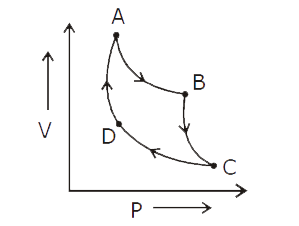For a given exothermic reaction , and are the equilibrium constants at temperatures and respectively. Assuming that heat of reaction is constant in temperature range between , it is readily observed that
The correct Answer is:C
Assuming
Similar Questions
In the P - V diagram, the point B and C correspond to temperatures T1andT2 respectively. State relationship between T1andT2.
 View Solution
View SolutionFor a given exothermic reaction , Kp and k'p are the equilibrium constants at temperatures T1 and T2 respectively. Assuming that heat of reaction is constant in temperature range reaction is constant in temperature range between T1andT2 , it is readily observed that
View Solution
Knowledge Check
- Question 1 - Select One
For a given exothermic reaction , Kp and k'p are the equilibrium constants at temperatures T1 and T2 respectively. Assuming that heat of reaction is constant in temperature range between T1andT2 , it is readily observed that
AKp>Kp'BKp<K'pCKp=K'pDKp=1K'p - Question 2 - Select One
For a given exothermic reaction , Kp and k'p are the equilibrium constants at temperatures T1 and T2 respectively. Assuming that heat of reaction is constant in temperature range between T1andT2 , it is readily observed that
AKp=K'pBKp=1K'pCKp>K'pDKp<K'p - Question 3 - Select One
For a given exothermic reaction, KpandK′p are the equilibrium constants at temperatures T1andT2 respectively. Assuming that heat of reaction is constant in temperature range between T1andT2, it is readily water that
AKp>Kp'BKp<Kp'CKp=Kp'DKp=1Kp'
χ1 and χ2 are susceptinilities of diamagnetic substance at temperatures T1K and T2K respectively. Then
View SolutionIf K1 is the equilibrium constant at temperature T1andK2 is the equilibrium constant at temperature T2and If T2>T1 and reaction is endothermic then
View Solutionχ1andχ2 are susceptibility of a paramagnetic material at temperatures T1 K and T2 K respectively, then
View Solutionx1andx2 are susceptibility of a Paramagnetic material at temperatures T1,KandT2K respectively, then
View SolutionFor an exothermic reaction, equilibrium constant at T1 and T2 are respectively K1 and K2 If K1<K2 then : -
View Solution

